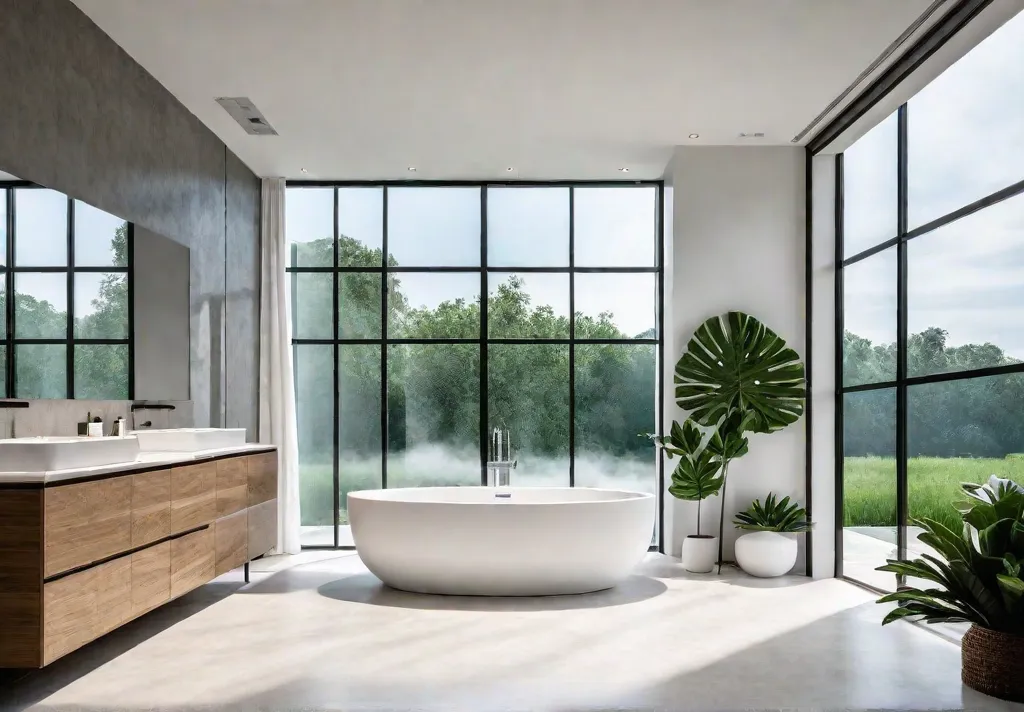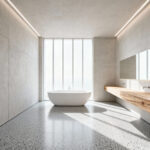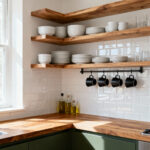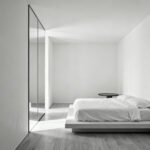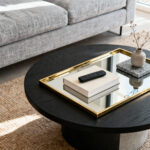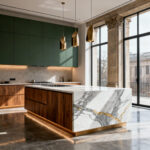Are you ready to make a splash with your bathroom renovation? As someone who’s always on the hunt for sustainable home solutions, I’m excited to dive into the world of waterproof flooring options that are both stylish and eco-friendly.
Whether you’re dreaming of a spa-like oasis or a bold, modern space, I’ve got you covered with seven fantastic choices that’ll keep your feet dry and your conscience clear. From classic tiles to cutting-edge materials, we’ll explore how to create a bathroom that’s not just beautiful, but also kind to our planet. So grab your favorite bamboo toothbrush, and let’s embark on this green adventure together!
Porcelain & Ceramic Tile: Classic Choices for a Reason
Today, we’re diving into the world of waterproof flooring for your bathroom, and I’m excited to share my thoughts on two classic options that have stood the test of time: porcelain and ceramic tiles. As someone who’s all about sustainable living, I love how these materials can be both eco-friendly and stylish when sourced responsibly.
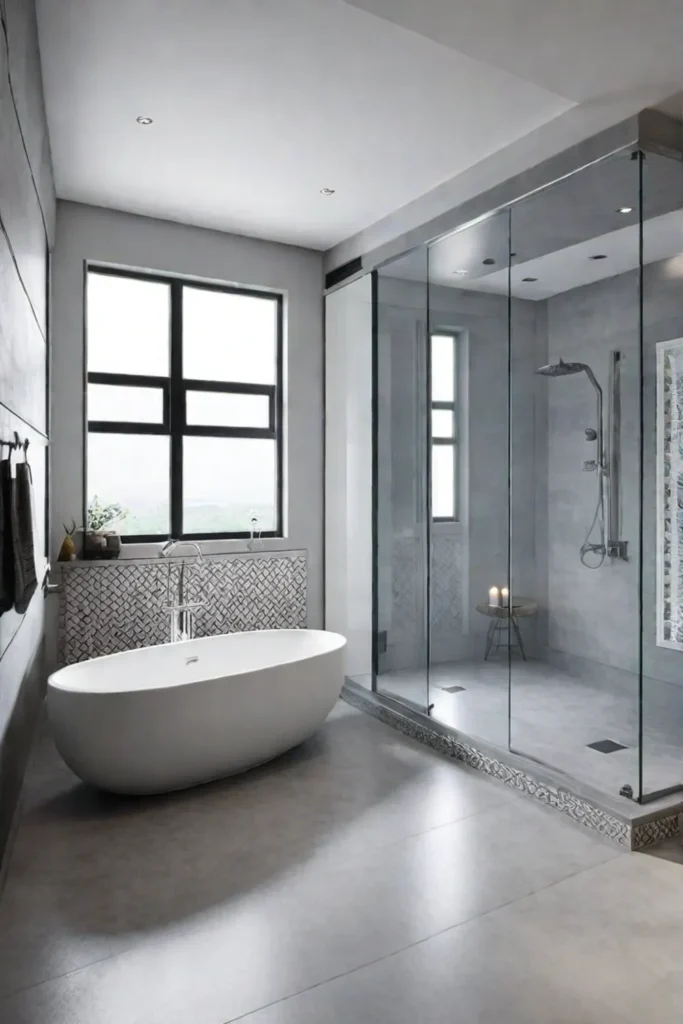
Porcelain vs. Ceramic: Understanding the Difference
Let’s start with the basics. Both porcelain and ceramic tiles are fantastic choices for bathroom flooring, but they do have some key differences:
- Porcelain tiles are denser and less porous, making them slightly more water-resistant than ceramic.
- Ceramic tiles tend to be more budget-friendly, which is great news for those of us trying to save some green while going green!
When it comes to water absorption rates, porcelain tiles typically absorb less than 0.5% of water, while ceramic tiles can absorb up to 3%. This means porcelain might have a slight edge in high-moisture areas like shower floors or around bathtubs.
Durability Meets Style
One of the reasons I adore these tiles is their incredible durability. They can handle heavy foot traffic, resist scratches, and stand up to those occasional dropped hairdryers (we’ve all been there, right?). But durability doesn’t mean sacrificing style! Here are some ideas to make your bathroom pop:
- Use large-format porcelain tiles for a sleek, modern look that can make small bathrooms feel more spacious.
- Get creative with patterned ceramic tiles as a decorative accent on the floor or shower walls. I’ve seen some gorgeous locally-made options here in Portland that add a unique touch.
- Mix and match different sizes and colors to create a custom design that reflects your personality.
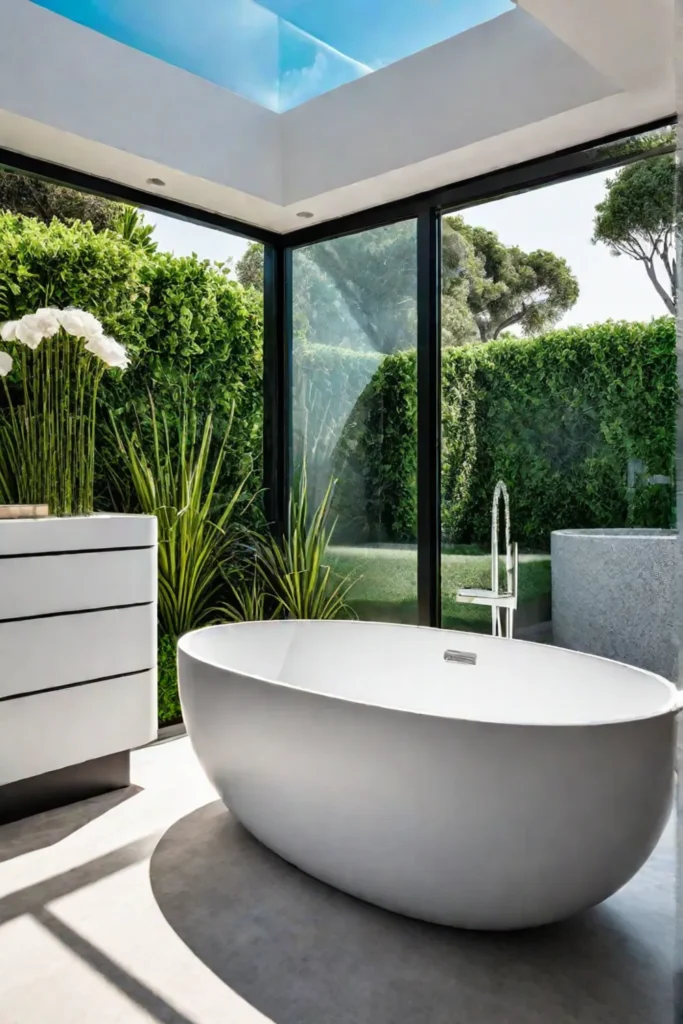
Maintenance Tips for Long-Lasting Beauty
To keep your tiles looking fabulous for years to come (and avoid unnecessary replacements), try these eco-friendly maintenance tips:
- Seal your grout lines regularly with a non-toxic sealant to prevent water damage and discoloration.
- Use natural cleaning solutions like vinegar and water to keep your tiles sparkling without harsh chemicals.
- Place a small rug or bath mat near high-traffic areas to reduce wear and tear.
Remember, proper installation is key to ensuring the longevity of your tile flooring. If you’re not confident in your DIY skills, it’s worth investing in a professional who can ensure everything is properly waterproofed and sealed.
Choosing the Right Grout
Don’t forget about grout! The color and type of grout you choose can dramatically affect the overall look of your tiled floor:
- Light-colored grout can brighten up a space but may show stains more easily.
- Dark grout can add contrast and hide dirt, perfect for busy bathrooms.
- Epoxy grout is more water-resistant and stain-proof than traditional cement-based grout, making it ideal for shower floors.
By carefully considering your tile and grout choices, you can create a bathroom floor that’s not only waterproof but also a beautiful reflection of your style and eco-conscious values.
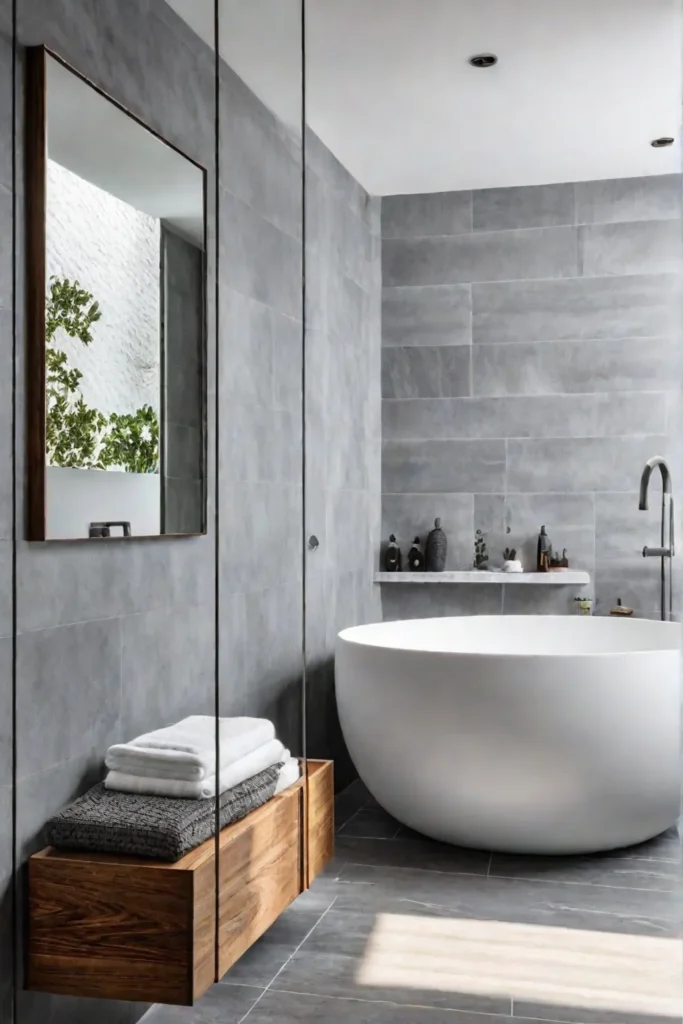
As we wrap up our discussion on porcelain and ceramic tiles, it’s clear that these classic options offer a perfect blend of durability, style, and water resistance for your bathroom. But what if you’re looking for something a bit different, perhaps with a softer touch underfoot? Well, you’re in luck! Let’s move on to explore the world of Vinyl Flooring: Budget-Friendly Versatility, where we’ll discover how this modern option can offer both comfort and practicality for your bathroom makeover.
Vinyl Flooring: Budget-Friendly Versatility
Let’s dive into the world of vinyl flooring – a surprisingly versatile and budget-friendly option for our water-prone bathroom spaces. As someone who’s always on the lookout for sustainable solutions, I’ve found that vinyl can be a great choice when you’re balancing eco-consciousness with practicality.
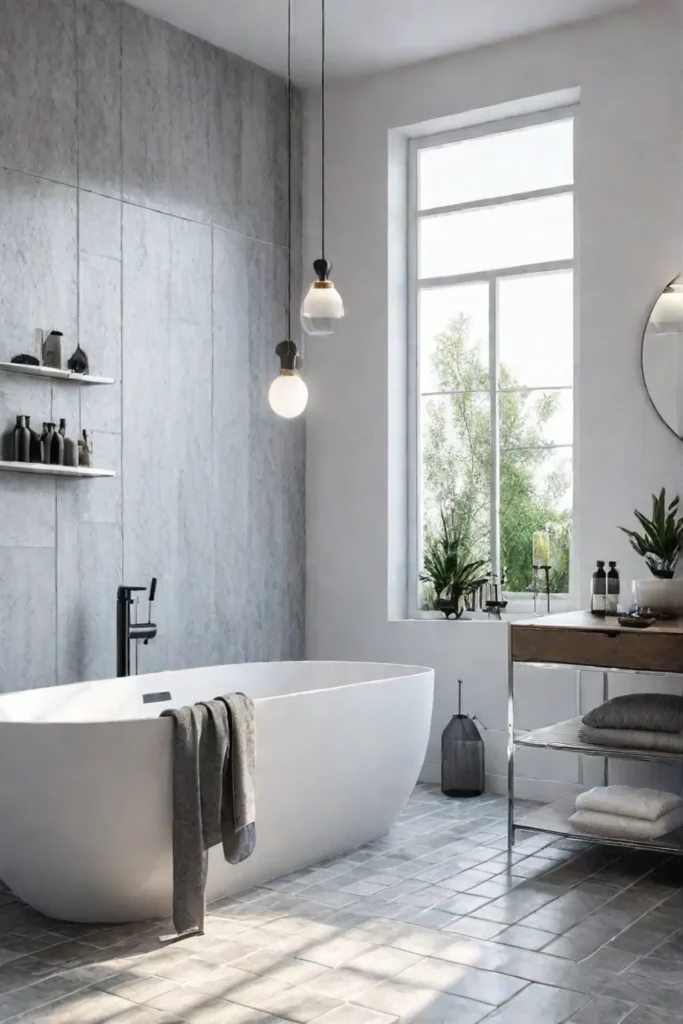
Sheet Vinyl vs. LVT: Which One is Right for You?
When it comes to vinyl flooring, we’ve got two main contenders: sheet vinyl and luxury vinyl tile (LVT). Both offer excellent water resistance, but they each have their unique qualities:
- Sheet Vinyl: This is your go-to for seamless, budget-friendly flooring. It’s perfect for those of us looking to minimize our spending while maximizing protection against water.
- Luxury Vinyl Tile (LVT): If you’re after a more high-end look, LVT is your best bet. It’s incredible how closely it can mimic natural materials – I’ve seen LVT that I could’ve sworn was real hardwood!
Factors to Consider When Choosing Vinyl Flooring
- Foot Traffic: How busy is your bathroom? For high-traffic areas, opt for LVT with a thick wear layer.
- Installation Method: Sheet vinyl is generally easier to DIY, while LVT might require a bit more skill.
- Aesthetic: LVT offers more variety in terms of design, perfect for creating that Pinterest-worthy bathroom.
- Eco-Friendliness: Look for vinyl options made with recycled materials or those that are recyclable at the end of their life.

Practical Tips for Vinyl Success
- For a cozy, farmhouse vibe, try wood-look LVT. It’s a great way to bring warmth into your bathroom without the worry of water damage.
- Enhance safety by choosing textured vinyl flooring. It provides a better grip, which is crucial in wet areas.
- When shopping for LVT, pay attention to the wear layer thickness. A higher mil number means better resistance to scratches and stains.
Did you know that with proper care, vinyl flooring can last up to 20 years in a bathroom setting? That’s some serious longevity for a budget-friendly option!
Water-Resistance Levels: Sheet Vinyl vs. LVT
Both sheet vinyl and LVT offer excellent water resistance, but sheet vinyl has a slight edge due to its seamless installation. LVT, while highly water-resistant, can have seams that might allow water to penetrate if not properly sealed. However, many LVT products now come with waterproof cores, making them equally suitable for bathroom use.

Remember, friends, while vinyl might not be the most eco-friendly option at first glance, its durability and longevity can make it a sustainable choice in the long run. By choosing high-quality vinyl and maintaining it well, we’re reducing the need for frequent replacements and ultimately minimizing waste.
As we move on from the practical world of vinyl, let’s step into the realm of luxury and timeless beauty. Our next stop? Natural Stone: Timeless Elegance with a Touch of Luxury. Get ready to explore how we can bring a piece of Mother Earth into our bathrooms while keeping our eco-conscious hats on!
Natural Stone: Timeless Elegance with a Touch of Luxury
Let’s move into the world of natural stone flooring for your bathroom. As someone who’s always on the lookout for sustainable and beautiful home solutions, I can’t help but get excited about the timeless appeal of natural stone. Let’s explore how we can bring a touch of Mother Nature’s elegance into our bathrooms while keeping things practical and eco-friendly.
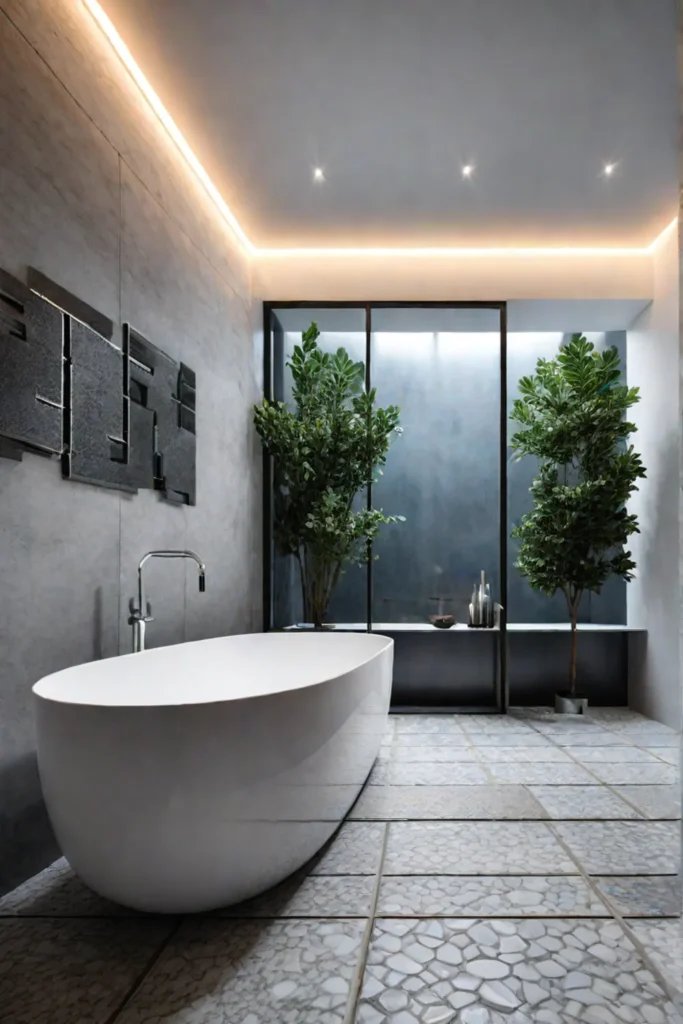
Popular Natural Stone Choices for Bathrooms
When it comes to natural stone options for your bathroom, you’ve got some seriously gorgeous contenders to choose from:
- Granite: This tough cookie is perfect for high-traffic bathrooms. It’s incredibly hard, resistant to scratches, and can handle the heat from your styling tools like a champ.
- Marble: If you’re dreaming of a spa-like retreat, marble is your go-to. Its classic, luxurious look can transform your bathroom into a serene oasis. Just keep in mind that it needs a little extra TLC.
- Slate: For my fellow modern design enthusiasts, slate is a game-changer. It’s natural texture and earthy tones can create a striking, contemporary look that’s sure to impress.
Here’s a pro tip: If you’re going for a bright, airy feel, opt for light-colored marble tiles. They’ll make your bathroom feel spacious and oh-so-zen. On the flip side, large-format slate tiles can create a bold statement floor that’ll have your guests swooning.
Sealing and Maintenance: Protecting Your Investment
Now, I know what you’re thinking – “Jane, these stones sound amazing, but aren’t they high-maintenance?” Well, yes and no. Natural stone does require some care, but with the right approach, it’s manageable. Here’s my step-by-step guide to keeping your natural stone floors looking fabulous:

- Seal regularly: This is crucial, folks. Sealing prevents water damage and staining, especially in wet bathroom environments.
- Clean gently: Use pH-neutral cleaners to avoid damaging the stone’s surface.
- Wipe up spills promptly: This prevents staining, especially on more porous stones like marble.
- Use mats: Place bath mats near showers and sinks to catch excess water.
- Re-seal as needed: Depending on the stone and usage, you might need to re-seal every 6-12 months.
Remember, each type of stone has its quirks. Granite is pretty low-maintenance, while marble might need a bit more attention. But trust me, the beauty and durability of natural stone make it worth the effort!
The Eco-Friendly Angle
As an environmental advocate, I always consider the sustainability factor. Natural stone is a fantastic choice because it’s, well, natural! It doesn’t off-gas harmful chemicals and can last for decades when properly maintained. Plus, many stone suppliers now offer reclaimed or locally sourced options, reducing the environmental impact of transportation.

When choosing your natural stone, look for suppliers who practice responsible quarrying and have environmental certifications. It’s a great way to ensure your beautiful bathroom isn’t coming at the cost of our planet.
As we wrap up our journey through the world of natural stone, I hope you’re feeling inspired to bring a piece of nature’s beauty into your bathroom. Remember, whether you choose the durability of granite, the luxury of marble, or the modern appeal of slate, you’re investing in a timeless material that can stand up to splashes and spills with grace.
Next up, we’ll be exploring a fantastic alternative that combines the warmth of wood with impressive water resistance. Get ready to discover how engineered wood can transform your bathroom into a cozy yet practical space!
Engineered Wood: Warmth and Water Resistance Combined
If you’re like me, torn between the allure of natural wood and the practicality of water-resistant materials, I’ve got great news for you: engineered wood flooring might just be the perfect compromise!
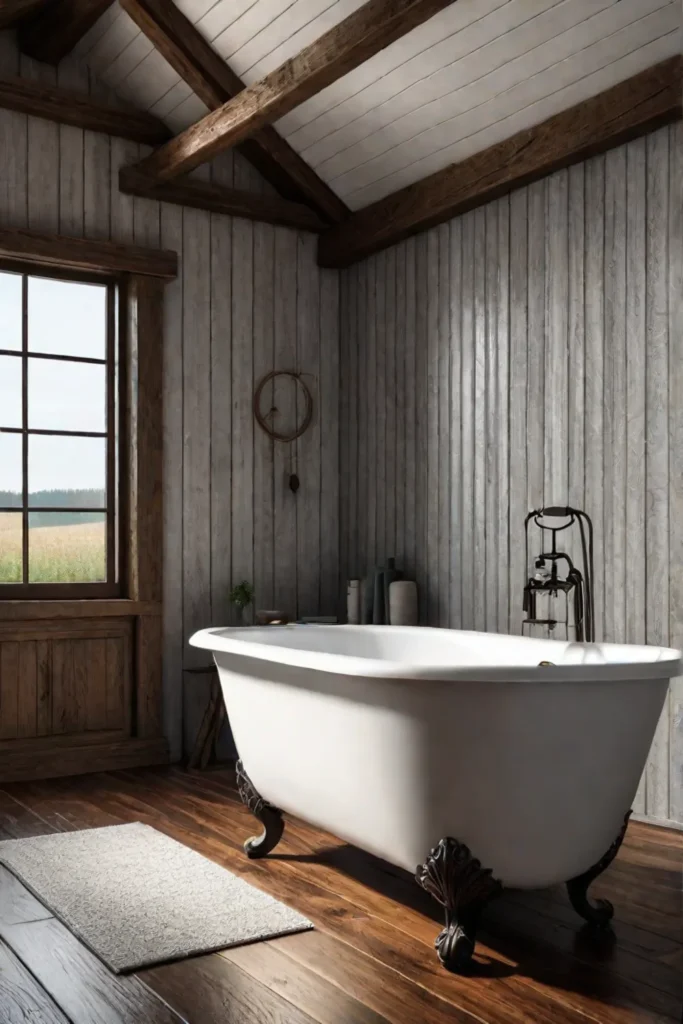
The Magic Behind Engineered Wood
Engineered wood is like the superhero of flooring materials. It’s got the heart of real wood but the strength of a carefully crafted composite. The secret? A layered construction that typically includes a plywood or high-density fiberboard (HDF) core topped with a gorgeous layer of real wood veneer. This clever design makes engineered wood more dimensionally stable than its solid hardwood cousin, meaning it’s less likely to warp or expand when exposed to moisture.
But here’s where it gets really exciting for us bathroom renovators: some manufacturers have taken it a step further by creating engineered wood with a completely waterproof core. Talk about a game-changer!
Choosing the Right Engineered Wood for Your Bathroom
When selecting engineered wood for your bathroom, keep these eco-friendly tips in mind:
- Opt for sustainably sourced wood species
- Look for low-VOC finishes to maintain good indoor air quality
- Choose wider planks to create a spacious feel (bonus: fewer seams mean less opportunity for water infiltration)
- Consider lighter wood tones to brighten up smaller spaces and make them feel airier
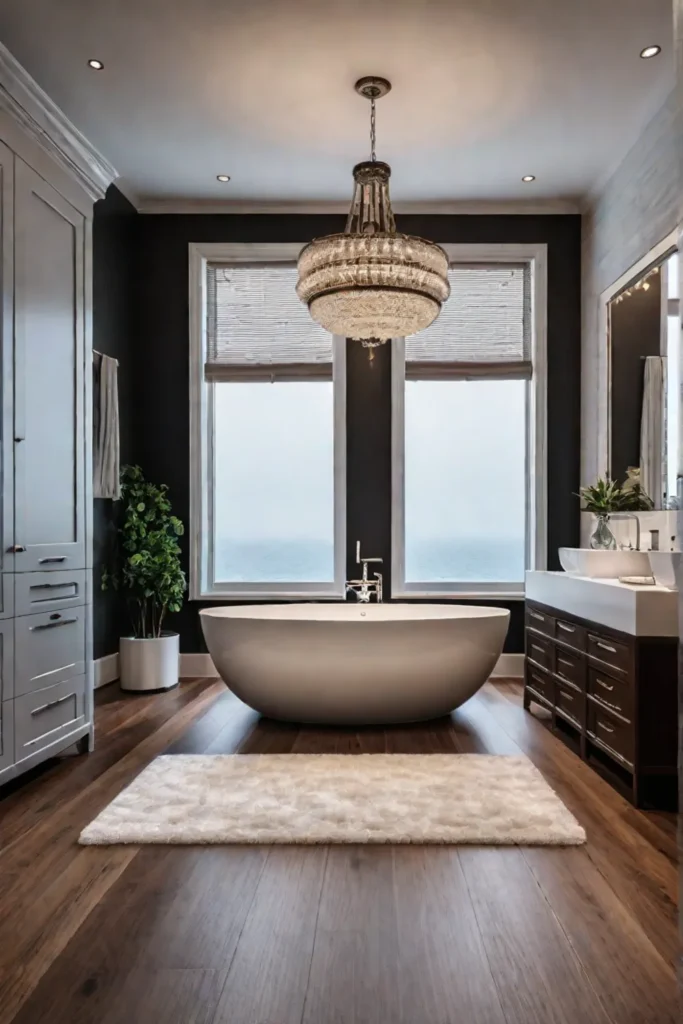
Remember, proper installation is key. Unlike other rooms, bathroom installation requires extra care to prevent moisture from seeping into the subfloor. Always work with a professional who understands the unique challenges of bathroom flooring.
Ventilation: Your Floor’s Best Friend
As someone passionate about creating healthy living spaces, I can’t stress enough the importance of good ventilation in your bathroom. Not only does it help prevent mold and mildew, but it also extends the life of your beautiful new engineered wood floor. Consider installing a high-quality exhaust fan or opening a window after showers to keep moisture levels in check.
The Eco-Conscious Choice
What I love most about engineered wood is how it aligns with sustainable living principles. By using less of the precious hardwood layer and combining it with fast-growing wood products in the core, engineered wood makes more efficient use of our forest resources. Plus, with its durability and long lifespan, you won’t need to replace it as often as some other flooring options.

So, if you’re looking to bring the warmth and beauty of wood into your bathroom without compromising on water resistance or environmental responsibility, engineered wood might just be your perfect match. It’s a choice that lets you enjoy the best of both worlds – natural aesthetics and practical performance.
As we continue our journey through waterproof flooring options, let’s shift gears and explore a material that’s been making a splash in modern design circles. Get ready to discover how concrete can transform your bathroom into an industrial chic oasis in our next section, “Concrete: Industrial Chic with Customizable Style.”
Concrete: Industrial Chic with Customizable Style
Let’s check out one of my favorite sustainable flooring options for bathrooms: concrete. It’s not just for sidewalks anymore, folks!
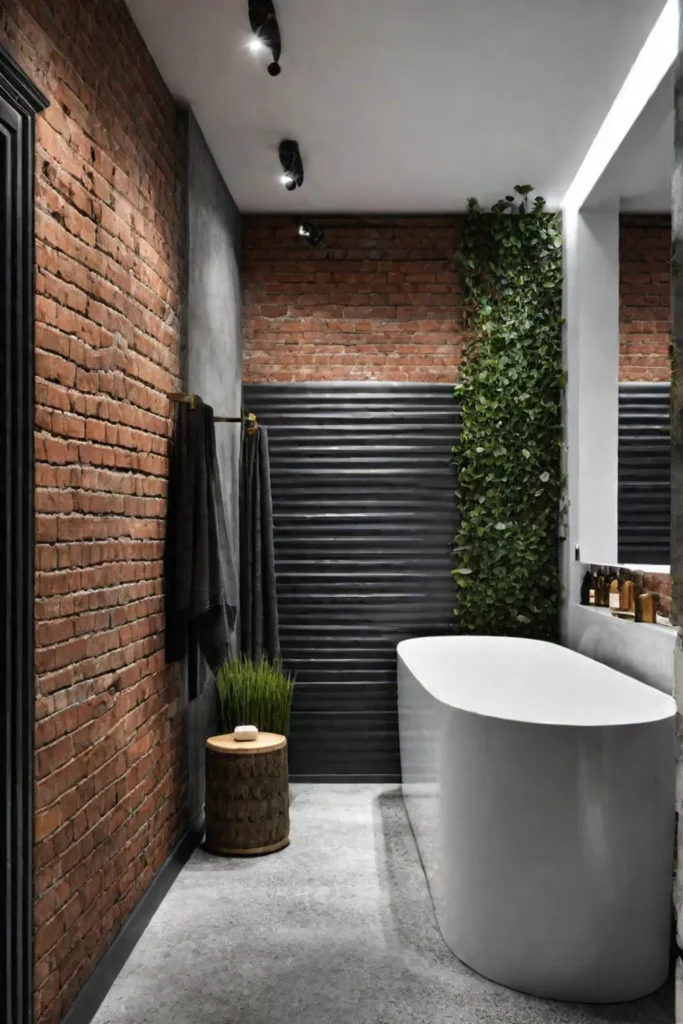
Types of Concrete Flooring Finishes
Concrete is like a blank canvas for your bathroom. You can go wild with:
- Polished concrete: Sleek and shiny, perfect for that minimalist Portland loft vibe.
- Stained concrete: Mimics natural stone without the hefty price tag or environmental impact.
- Stamped concrete: Adds texture and can even replicate the look of tile or wood.
I once visited a local eco-friendly home that had a gorgeous dark gray polished concrete floor paired with crisp white walls. Talk about industrial chic!
Pros and Cons of Concrete in Bathrooms
Pros:
- Durability (it’ll outlast your favorite pair of Birkenstocks)
- Water-resistant (goodbye, mold!)
- Customizable (unleash your inner artist)
- Low maintenance (more time for hiking in Forest Park)
Cons:
- Can be cold and hard underfoot (but we’ve got solutions for that)
- Requires proper sealing (DIY project, anyone?)
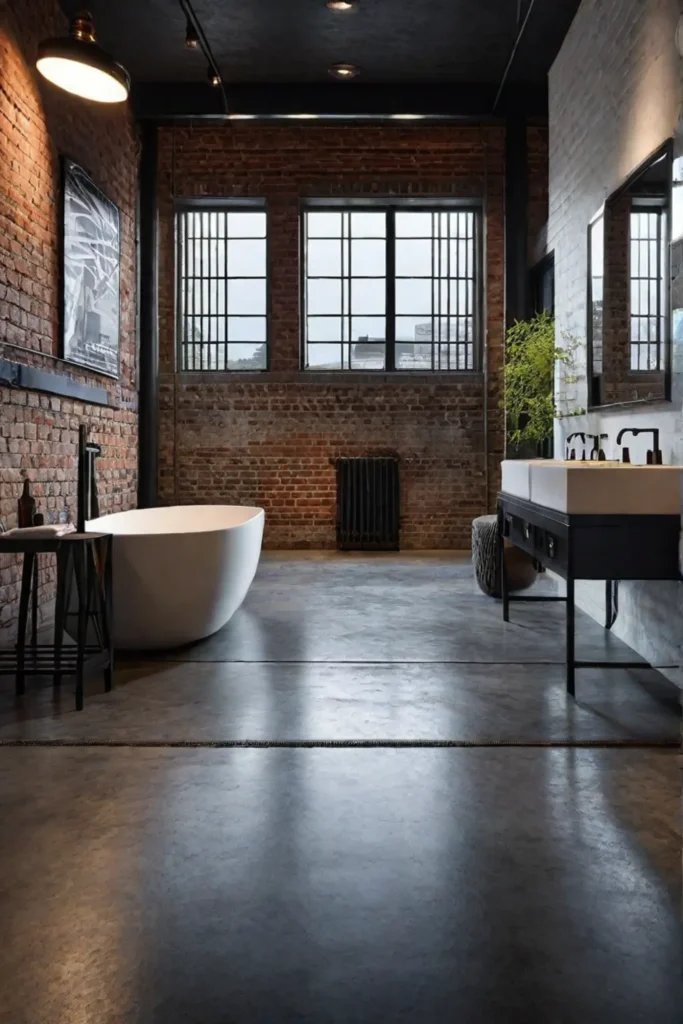
Making Concrete Comfortable and Eco-Friendly
I get it – the idea of stepping onto a cold, hard floor first thing in the morning isn’t exactly enticing. But fear not! Here are some eco-friendly ways to make concrete more comfortable:
- Install radiant heating: It’s energy-efficient and feels like a warm hug for your feet.
- Use sustainable rugs: Think bamboo, jute, or recycled materials.
- Cork bath mats: They’re renewable, biodegradable, and oh-so-comfy.
Sealing the Deal: Protecting Your Concrete Floor
Proper sealing is crucial for concrete bathrooms. Here are your options:
- Penetrating sealers: These soak into the concrete, offering invisible protection.
- Topical sealers: Create a protective layer on the surface, often adding shine.
- Epoxy coatings: Durable and waterproof, perfect for high-moisture areas.
Pro tip: Look for low-VOC sealers to keep your bathroom air quality top-notch!
Creating a Spa-Like Oasis with Concrete
Want to turn your bathroom into a zen retreat? Try a light-colored concrete floor paired with warm wood accents and plenty of plants. It’s like bringing a piece of the Pacific Northwest indoors!
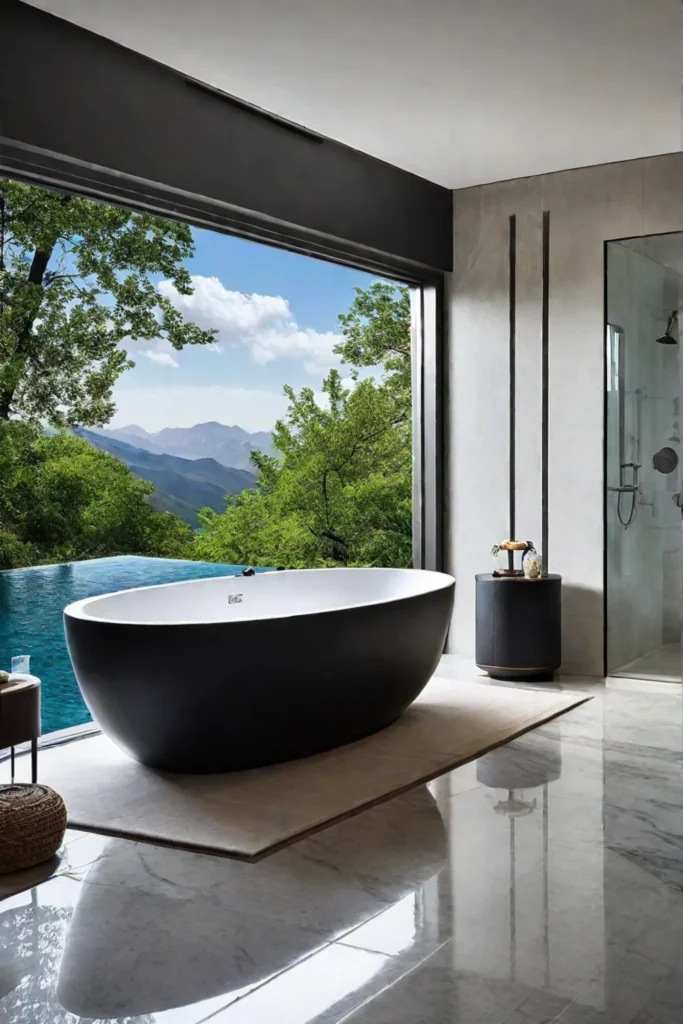
Remember, choosing concrete for your bathroom isn’t just a style statement – it’s a sustainable choice. Its longevity means less waste in landfills, and its versatility allows you to change up your look without replacing the entire floor.
As we wrap up our journey through waterproof flooring options, it’s clear that there’s no shortage of sustainable and stylish choices for your bathroom. From the industrial chic of concrete to the other materials we’ve explored, you’re well-equipped to make a splash with your flooring decision. In our conclusion, we’ll recap the key points and help you navigate the final steps of choosing the perfect waterproof flooring for your eco-friendly bathroom oasis.
Wrapping Up
Whew! What a journey through the world of waterproof bathroom flooring, right? From the timeless appeal of porcelain and ceramic tiles to the industrial chic of concrete, we’ve explored a range of options that prove you don’t have to sacrifice style and sustainability for practicality.
Remember, friends, every choice we make in our homes has an impact on our planet. By opting for durable, long-lasting materials and maintaining them properly, we’re not just creating beautiful spaces – we’re reducing waste and living more sustainably. So whether you’re drawn to the warmth of engineered wood or the versatility of vinyl, know that you’re making a choice that’s good for your home and good for the Earth. Now, go forth and create that eco-friendly bathroom oasis of your dreams!
